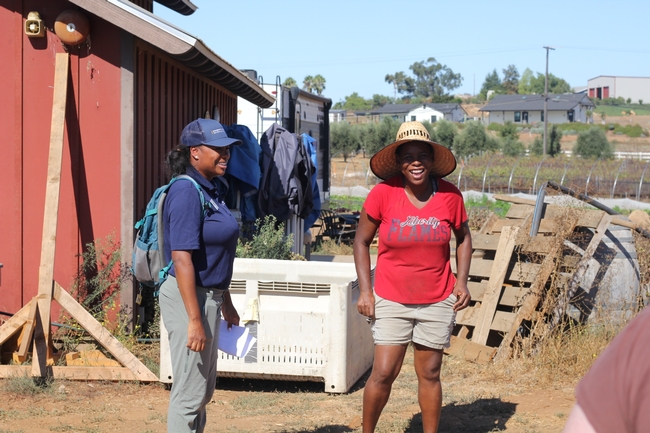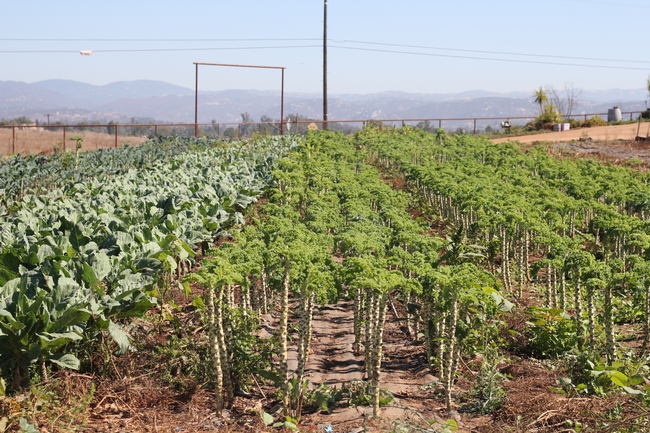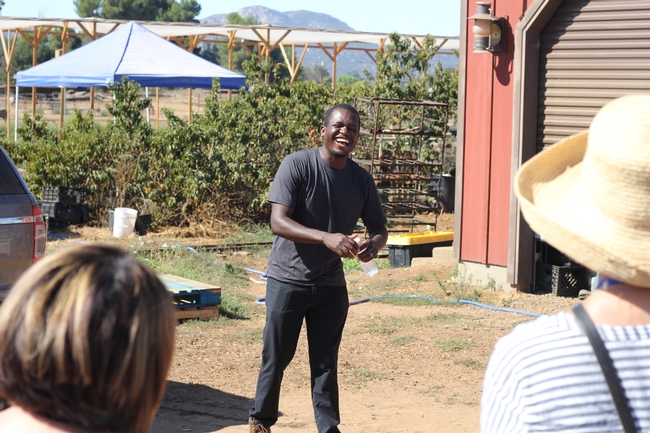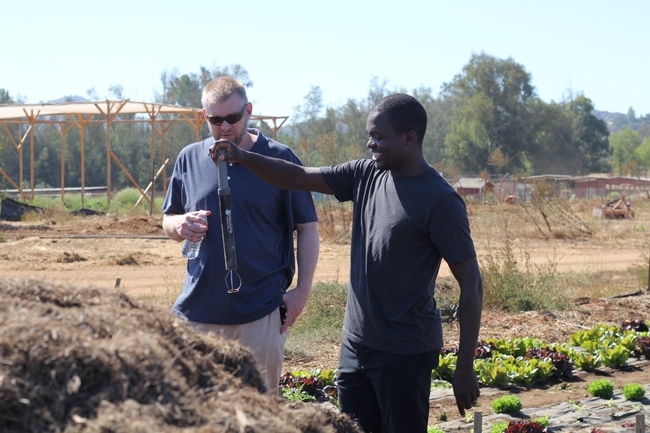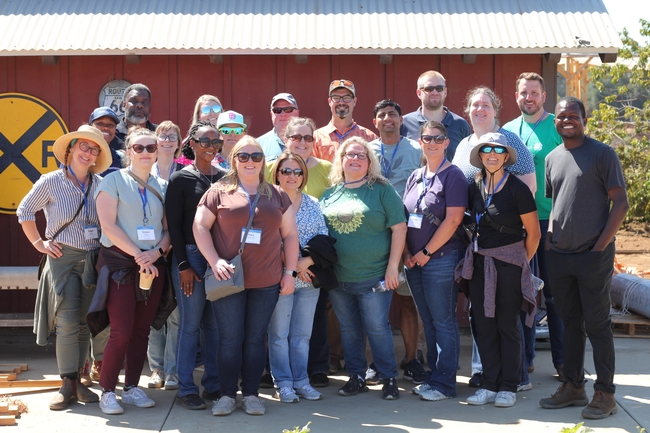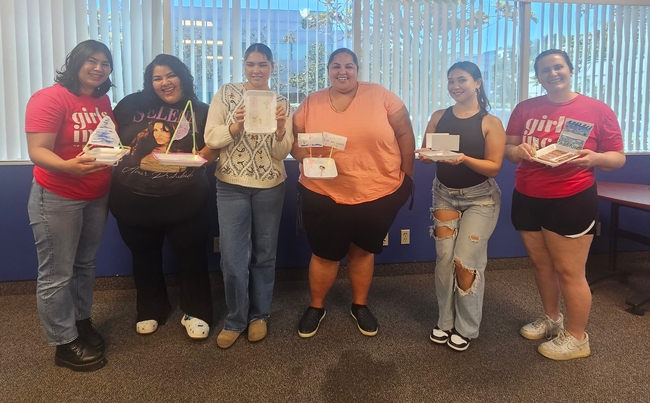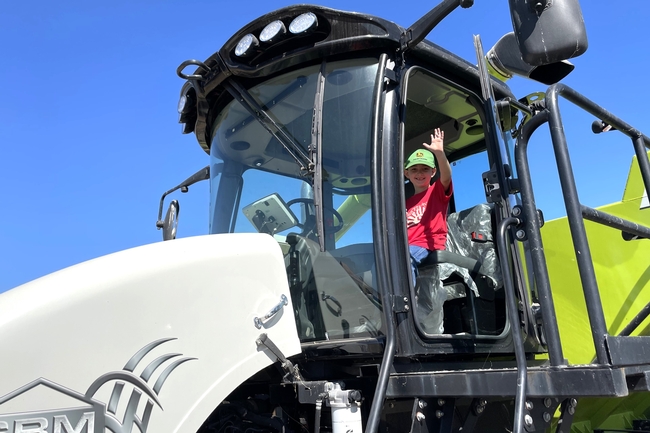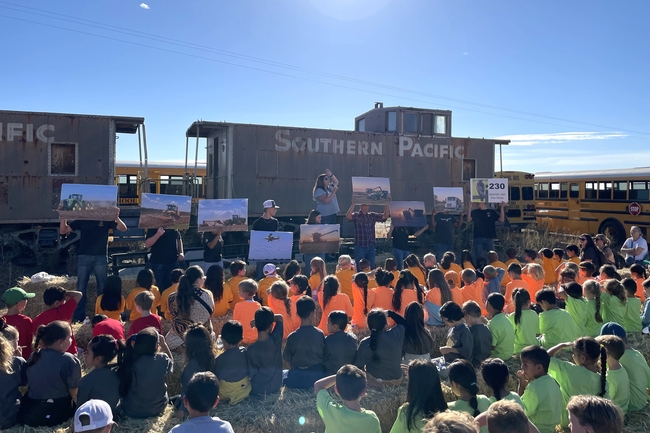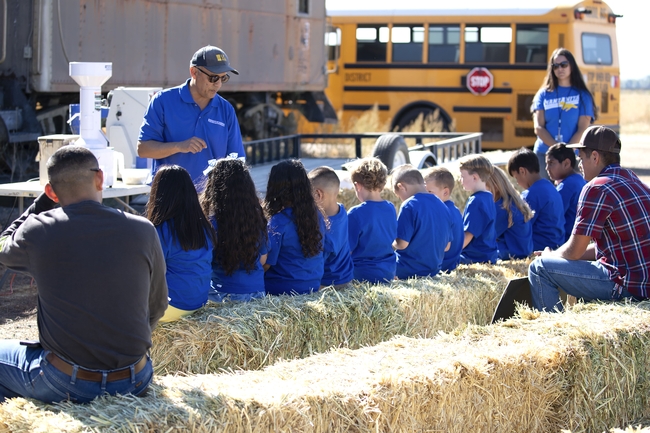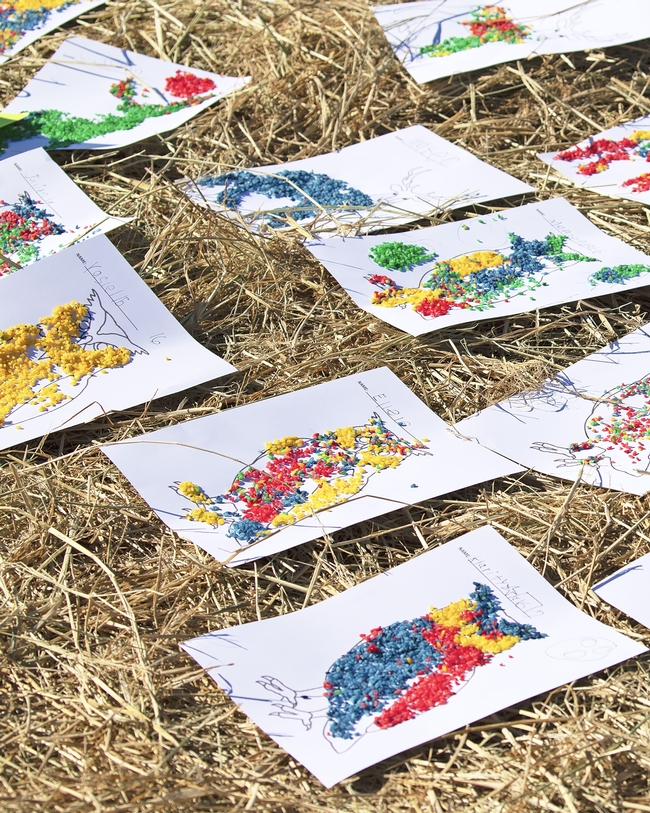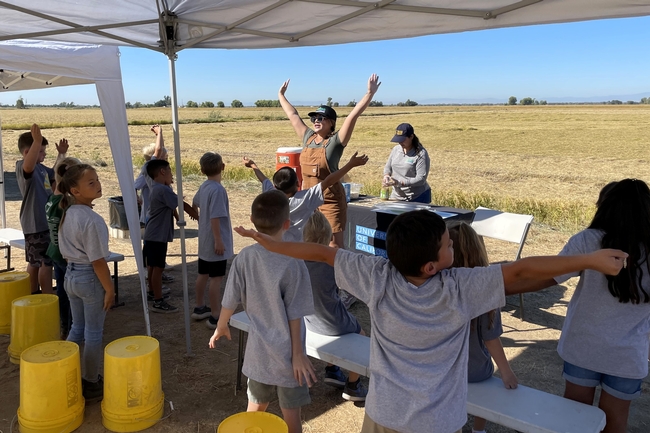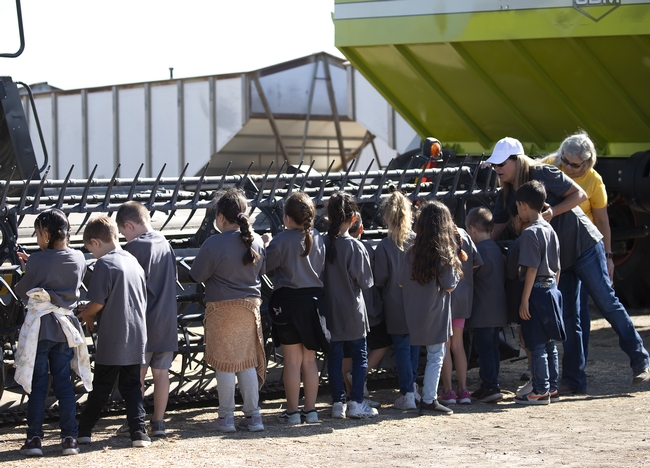Main story
UC ANR project to help underserved farmers in SoCal with land ownership
San Diego County has more than 5,000 small farms but less than 2% are operated or owned by Black, indigenous, or people of color – including those of Asian, Hispanic or Native Hawaiian/Pacific Islander descent, according to the 2022 Ag Census.
The reasons vary, but historically, multiple marginalized communities of color have not received the same opportunities or support for land ownership or management as their white counterparts.
Chandra Richards, University of California Cooperative Extension land equity academic coordinator for the Southern California region, is identifying barriers to equity when it comes to addressing land access, tenure, management and opportunities to increase the diversity of land managers and land ownership in the region.
Richards is the principal investigator for the Climate Action and Land Equity (CALE) project administered through UC Agriculture and Natural Resources and funded by the Department of Conservation. CALE aims to engage historically underrepresented communities in coalition building, capacity assessment and climate action planning. CALE elevates knowledge about the challenges and opportunities to land access and management for a diversity of land managers.
Among the challenges is land tenure, an established agreement between a landowner and tenant, outlining the purpose and use of the land over a period of time. However, when landowners decide to sell their land, these agreements are at risk of being null and void, forcing the tenants to renegotiate or discontinue their operation.
Land tenure leases for under five years are considered short-term, which are common in Southern California. For small, new and under-resourced farmers, landowner turnover doesn't just threaten their business plan but their livelihood.
For small farmer Byron Nkhoma, who leases land in Ramona to grow leafy greens and vegetables, the possibility of losing land is a constant worry. Since 2015, Nkhoma and his wife, Joyce, have been renting four of 20 acres to establish Hukama Produce. Over nine years, they have had two landowners. Before the land was sold to his current landowner, Nkhoma said he considered buying land, but the process proved more challenging than he thought.
“What it takes for someone like Byron to find a place to farm and establish a food system is an extremely involved process,” said Richards. “It's not just learning how to obtain land, it's also about managing that land so it can be used for years and generations to come.”
Originally from Zimbabwe, Nkhoma is adamant about taking care of the land he leases and has applied knowledge from his home to ensure resilience. Hukama Produce prides itself in improving environmental health through sustainable farming practices such as compost and mulch application, drip irrigation and low till. An important pillar of the CALE project includes building capacity and providing technical assistance toward land conservation and climate resiliency.
In addition to land tenure, money and time are stressors for small farmers. When they are not working on the farm, Nkhoma and his wife are researching and applying for grants to improve their soils and protect their crops from pests. However, many grants for which Hukama Produce is eligible often have pressing deadlines that demand their immediate attention – cutting into valuable time that could be spent tending to the land or selling at farmer's markets.
Two of Hukama's goals include building and sustaining trust in the market and growing their operation. By partnering with Richards, Hukama Produce has direct access to technical assistance focused on grant writing and conservation to increase ecosystem health and build tenure.
Agricultural land tenure is the arrangement, rights, and responsibilities centered around use, management, and ownership of agricultural land and resources. Building land tenure means that farmers have a stable place to grow their crops and build environmental sustainability without risk of having to move their operations.
While the CALE project boosts support for historically underserved community members hoping to own or manage land, it prioritizes land use for food production as a reinvestment into the greater community.
Eager to bring realities like Nhkoma's to light, Richards partnered with Keith Nathaniel, UCCE director for Los Angeles County, who co-coordinated the Western Extension Leadership Development conference held in San Diego the week of Sept. 23-27. WELD unites Cooperative Extension faculty, agents, advisors, educators and specialists from the western region of the United States for a two-year leadership development program.
While in San Diego, WELD participants joined Richards for a tour of Hukama Produce and learned directly from Nkhoma about opportunities and threats as a small farmer. The tour ended with participants in a circle, sharing how their professional roles can offer support to Hukama Produce and other small farms.
“We grow food so that we can feed the community,” said Nkhoma. “When we feed others, we build relationships. That's what ‘hukama' means – to grow relationships.”
If you operate or know of a small farm in Southern California and would like to be involved with or receive regular updates about the CALE project, please contact Chandra Richards at cmrichards@ucanr.edu.
If you are interested in applying for the Land Equity Project Manager position, please visit https://ucanr.edu/About/Jobs/?jobnum=2894 for details.
4-H ag tech breakfast to support next generation of leaders, innovators
Event at FIRA USA in Yolo County includes look at agricultural robotics, automation
The FIRA USA ag tech conference, Oct. 22-24 in Woodland, showcases the latest robotics and automation innovations. A special breakfast during the event will support tomorrow's leaders, scientists and engineers who will realize the potential of those technologies.
Proceeds from the breakfast (Thursday, Oct. 24, 7:30 to 9 a.m. at the Yolo County Fairgrounds) will benefit higher education scholarships for 4-H youth participants interested in applying technology to a wide array of agricultural practices.
During the breakfast, attendees will hear from 4-H alumni – including Glenda Humiston, University of California vice president for agriculture and natural resources – on the impact of their participation in the program.
As a leading nationwide youth-development organization, 4-H delivers research-based, positive youth development practices through its community-based programs. Youth gain life and work readiness skills through hands-on projects. Studies have shown that youth who engage with 4-H programs are more likely to:
- Achieve academically
- Serve in leadership roles in school and community
- Engage in some form of community service
“4-H clubs, project teams and after-school programs develop skills in areas ranging from animal science to robotics, and from natural resources to coding,” said California 4-H Director Kimberly Sinclair Holmes, who will speak at the breakfast. “Scholarships help ensure those seeds of interest and passion blossom into meaningful careers that contribute to agriculture and society.”
Tickets are $100 each and can be purchased at https://bit.ly/4-HFIRAEvent.
The ticket includes all-day access to FIRA USA, touted as “the largest robot playground in the world,” where attendees can get an up-close look at laser weeders, autonomous harvesters, drone applications and a host of other ag tech innovations.
FIRA USA is a collaboration of GOFAR (Global Organization for Agricultural Robotics), Western Growers, UC Agriculture and Natural Resources, and The VINE.
UC Master Gardeners of Imperial County grow from Mexican, Latino roots
First program of its kind in area establishes free seed library, community garden
One of the many things that make University of California Cooperative Extension in Imperial County unique is its close proximity to the U.S.-Mexico border. Its geographic location, with a border town called “La Frontera” by locals, infuses the UC Master Gardener Program in this area with intercultural knowledge.
In 2022, UCCE launched its first UC Master Gardener Program in the county and has maintained a cohort of 20 participants since then. Kristian Salgado, the program's first coordinator, said the volunteers offer a range of skills to the gardening community.
“The clientele that our volunteers serve tend to be individuals who have gained their gardening knowledge and experience from tending to plants in their homeland of Mexico,” said Salgado. The volunteer UC Master Gardeners of Imperial County reflect the region's predominantly Latino demographic, making it easier for volunteers to connect with their clientele.
“Nopales, chiles, citrus…residents in this region know how to take care of these plants. They've done it all their life. But when you have a program like the UC Master Gardener Program, you can use science to explain why their practices worked all these years,” said Salgado.
According to Salgado, the UC Master Gardener Program can be perceived as too academic for some residents. “It's not a bad thing, but I had to digest the information myself, even the UC Master Gardeners, and figure out how to deliver it in a way that was relevant to everyone,” she added.
As a starting point, Salgado used English and Spanish materials from neighboring counties like “A Garden of Words/Un jardín de palabras”, developed by the UC Master Gardener Program of Los Angeles County.
One method that helped engage volunteers and residents during classes was the use of culturally significant seeds like chiltepin peppers – seeds that Salgado deems a “must-have” if you are a gardener of Mexican heritage.
“When we focused on plant propagation, the volunteers that I worked with agreed that we should propagate plants that our residents were familiar with and use in their everyday cooking,” Salgado explained.
This same approach was employed at the free seed library and demonstration garden – both established and maintained by the UC Master Gardener volunteers at the City of Imperial Public Library. During the warm season you can find Roselle (Hibiscus sabdariffa L.), known to make agua de jamaica, in the seed library – something you won't easily find in grocery stores. In the demonstration garden during the summer, you'll notice a variety of peppers such as chile güero, jalapeño, serrano and habanero.
As the UC Master Gardener coordinator for Imperial County for the last two years, Salgado has focused her leadership on establishing a program that would generate opportunities for UC Master Gardener volunteers to create projects that are reflective of their interests, align with the program's mission and serve all residents in the county. The demonstration garden, which is the first community garden established in the city of Imperial, is an outcome of Salgado's vision.
UC Master Gardener Program reflects, connects community
Eliza Barajas, UC Master Gardener of Imperial County, who works at the library during the week and has witnessed the impact of the garden, said it gives her a sense of pride. “I moved to the [Imperial] Valley a year ago and I was looking for a way to connect with the community. I couldn't have asked for a better program to do that, and I'm so proud to say that I'm a part of the very first cohort in Imperial County,” Barajas shared.
Salgado praised Barajas for her enthusiasm in the program and noted her excellent ability to speak Spanish. “I love the way Eliza flows from English to Spanish. It's effortless! And it comes in handy when we're doing community events and need to cater to our Spanish and English speakers,” said Salgado.
Since the program came to fruition, Salgado has played a pivotal role in the program's progress. Reflecting on why she accepted the role of UC Master Gardener coordinator for Imperial County, Salgado said that the role was a culmination of everything she studied in school and cares deeply about.
While attending California State Polytechnic University, Humboldt, Salgado earned a master's degree in social science focused on the environment and community. She studied the intersections of food insecurity, the agricultural industry and health inequities, and how they specifically impact the Latino community.
Growing up and currently living in Calexico, Salgado questions why her community is food insecure. “Imperial is the ‘salad bowl' of the nation. We export a variety of fresh fruit and veggies all year long. How is it that our community doesn't have enough access to the healthy food it produces?” she asked.
Food security is one concern that Salgado envisions the UC Master Gardener Program addressing through its seed library, community garden and gardening classes.
Following graduate school, Salgado moved back home and joined former classmate and UCCE colleague, Chris Wong, in establishing the first farmer's market in Calexico in 2013. Wong encouraged Salgado to apply her new knowledge and skills at UCCE Imperial County, where she began working as a climate-smart agriculture community education specialist in 2019, supporting growers with grant writing.
“I realized early on that there was a lot of divestment in the community, and I didn't understand why,” she said, adding that she's still working to understand. Salgado's mother-in-law also continuously challenged her to think bigger. “My mom-in-law comes from the Chicano Movement. She's guided me into thinking more critically about the issues we face in our community and as Latinos.”
In September, Salgado began in a new role as the regional operations specialist for the UC Master Gardener Program statewide office, covering the Bay Area to Southern California regions. Salgado hopes to develop useful tools and resources to support coordinators' professional development, while integrating programmatic best practices centered on diversity, equity, inclusion and justice.
“The UC Master Gardeners are full of knowledge, and my education was motivated by identifying how Latinos can get a seat at the table. UC Master Gardeners easily become trusted sources in the community, and for Imperial County, this is how they get a seat at the table,” said Salgado.
San Diego County goes green for National 4-H Week with proclamation, lighting ceremony
National 4-H Week is Oct. 7-12, 2024. To celebrate, the San Diego County Board of Supervisors will be recognizing the significant benefits to local youth provided by the UC Cooperative Extension 4-H Youth Development Program in San Diego County with a proclamation on Tuesday, Oct. 8. This recognition will take place at 9 a.m. during the board's meeting at the County Administration Center, 1600 Pacific Highway, San Diego, CA 92101.
In California, 4-H is administered through county-based UC Cooperative Extension advisors and educators who provide practical knowledge to people, businesses and communities via science-based research and educational programs. The proclamation not only celebrates 4-H's impact in San Diego County, but also acknowledges the successful partnership between UCCE and the County of San Diego.
As a leading youth-serving organization nationwide, 4-H offers research-based programs that equip young people with life skills, leadership training and community engagement opportunities. It also provides professional development and resources for other youth-serving organizations throughout participating counties, including San Diego.
Liliana Vega, UCCE 4-H youth development advisor for San Diego and Orange counties, envisions her expertise in justice, equity, diversity and inclusion enhancing positive youth development for all, especially Black, indigenous and people of color. Eager to create culturally relevant experiences that resonate with young people, Vega believes that doing so starts with empowering youth-serving professionals with growth opportunities, equipping staff to engage with the community meaningfully and prioritizing diversity.
“By partnering with local organizations, schools and diverse community groups in San Diego, we can elevate the quality and reach of youth programs throughout the county. Together, we can enhance opportunities in STEM, environmental justice, the arts and workforce development for the next generation,” said Vega, while describing the program's collaboration with the YMCA and Girls Inc. in San Diego as excellent examples.
At sunset on Oct. 8, attendees and passersby will witness the County Administration Center lit in the program's iconic green color, symbolizing the organization's century-long commitment to youth development in San Diego County. The proclamation and lighting ceremony are open to the public, and individuals whose lives have been enhanced by 4-H are encouraged to attend.
For more information about UCCE's 4-H program in San Diego County and details on how to get involved, please visit https://ucanr.edu/sites/4HSanDiegoCounty/. You can also contact Rebeca Manzo at remanzo@ucanr.edu or Liliana Vega at live@ucanr.edu.
Butte County first graders enjoy ‘ricetastic’ day at local farm
UC Cooperative Extension advisors, educators join growers in showcasing rice production
When Tracy Schohr volunteered in her son's pre-K class a couple years ago, she was stunned to find out that only two of the 20 children had ever been around a tractor. And this was in the rural Butte County community of Gridley, in the heart of California's rice-growing region.
Seeking to introduce more young children to agriculture, Schohr – the University of California Cooperative Extension livestock and natural resources advisor for the area – and her friend Lisa Donati created an event to showcase rice farming.
After the debut of “Ricetastic Day” last year with about 140 students from Gridley in attendance, this year's event on Sept. 19 attracted more than 240 schoolchildren – this time from across south Butte County.
First graders from McKinley Primary School in Gridley, Manzanita Elementary School, Biggs Elementary School and Richvale Elementary School – along with their teachers and many family members – enjoyed hands-on experiences at Schohr's rice and cattle ranch.
“There's a dwindling population that produces the food that we eat across America, so how can we have more people know, appreciate and love agriculture if we don't give them that opportunity?” said Schohr. “That's what this day is really about – to teach them about rice, to teach them about their community, how healthy rice can be, and how the farming and ranching can also create habitat for wildlife. It's all-encompassing.”
Event stations share different aspects of rice
Schohr, who grew up on the family ranch in Gridley, remembers coming with her McKinley schoolmates for a visit. But those field trips had comprised only lunch and a quick “drive-through” tour of the historic farming operation.
For Ricetastic Day, however, Schohr organized – with generous help from local growers and community partners – a more comprehensive half-day of activities. After her brother, Ryan Schohr, welcomed the participants to the family farm, the students formed groups that were led by Gridley FFA youth on a rotation through a variety of stations.
At the milling station, Luis Espino, UCCE rice farming systems advisor, demonstrated how his mini mill machines remove the husks from rough rice to make brown rice, and then polish away the bran layer to make white rice. He had the children see and feel the difference as the rice moved through processing.
“I didn't even know brown rice existed!” exclaimed Elsie, a first grader at McKinley.
A native of Peru, Espino came to study agriculture through his lifelong fascination with biology and living things – and he said events like Ricetastic Day can inspire a similar passion in young people.
“It might spark their curiosity so that they might go into these areas of work in the future or have a career in agriculture, when they see that people do this for a living,” Espino said.
Ray Stogsdill, another McKinley school alumnus, returned to Gridley after college to pursue just such a career. A staff research associate in the lab of UC Davis professor Bruce Linquist, Stogsdill manages on-farm rice variety testing across the region. He volunteered to help Schohr with Ricetastic Day by talking about some of the heavy equipment and providing his perspective for the kids.
“They drive by the fields and they don't know what's out there,” he said. “This gives them a chance to know what they're driving by, so they can say, ‘We have rice here and this is how it works; this is how it grows.' It gives them an idea of what's going on around them.”
Where rice fits within a healthy diet was the focus for the CalFresh Healthy Living, UC Cooperative Extension team, comprising nutrition educators Sunshine Hawjj, Joanna Aguilar and Kenia Estrada, as well as community nutrition, health and food security advisor Veronica VanCleave-Hunt. They talked about how rice – like other grains in that vital food group – gives people energy, and then taught the students an energetic “ricetastic” movement activity.
“Because our program is part of UC Agriculture and Natural Resources, it's important to make the connection between where our food comes from and how it gets on our plate – especially with young kids, so that we can promote value for our local agriculture and our food systems,” VanCleave-Hunt explained.
Activities spark further conversations, learning about agriculture
With rice harvest late due to late planting in the spring, Eric Waterbury of Waterbury Farms was able to take some time to attend the event. Although his family has been growing rice for three generations, he said he appreciates opportunities for the broader community to see all aspects of his work – from the equipment to the processing.
“If the kids walk away from this with one thing, I hope it's that they realize every time they have a meal, somebody was out there working hard to provide that meal,” he said. “It wasn't just the person at the grocery store that provided it for them.”
Schohr added that Ricetastic Day was only possible through the support of the community. Butte County Farm Bureau and Natural Resources Conservation Service staff helped kids make art with colorful dyed rice; neighboring farmer Tinker Storm described how the harvester and “bankout” wagon work; and rice farmers Shelley Beck and Sue Orme read aloud “Daddy's Got Dirt: A California Rice Story,” a children's book written by a local rice grower.
With rice at the center of physical activities, arts and crafts, and science lessons for the day, the students learned a lot to take home.
“It's nice that the kids got these hands-on learning experiences,” said Ryan Schohr, “so they can go home tonight and, at the dinner table, talk about it with their parents or brothers and sisters, over dinner or over homework – and share what they learned here on the farm and about their community.”
Rebecca Christy, a first- and second-grade teacher at Biggs Elementary, said she is excited to return to the classroom and hear from her students about all that they learned during the day.
“Every morning right now I'm seeing the big trucks going by our school, and so I'll be able to point that out to them, ‘Where are they going? What are they doing?'” she said. “I can't wait to get back to school and let them tell me about all of this.”
One of her students, Ximena, was finishing her brownbag lunch as the group watched one of the Schohr Ranch harvesters rumble over the field. Despite enjoying a rice cake and a rice cracker earlier, she said her meal was missing one thing.
“Where is my rice, Miss Christy?” she said. “I want rice!”

